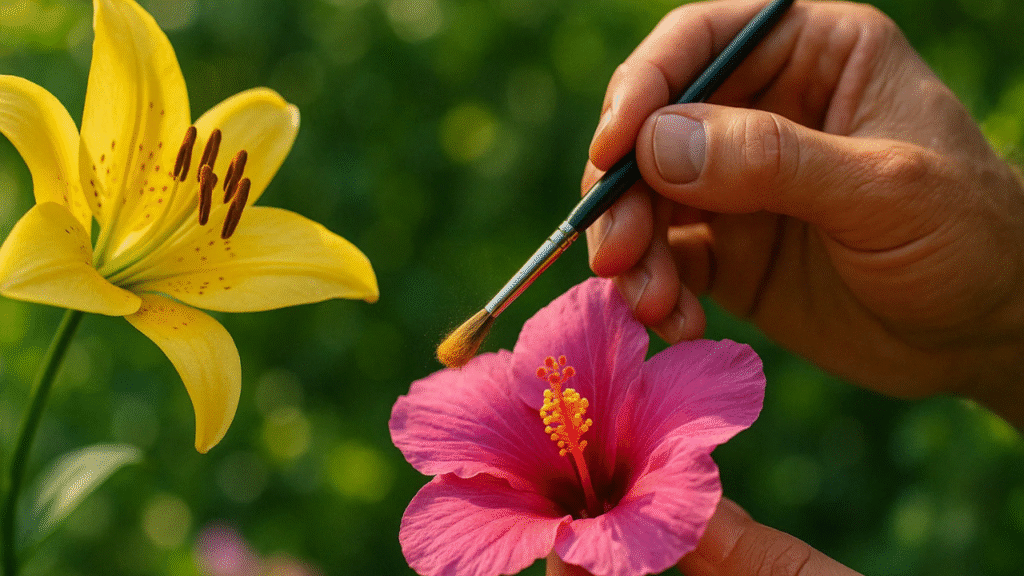
Creating New Plant Cultivars by Cross-Pollination: A Comprehensive Guide to Hybridization
Have you ever wondered how those vibrant new flower varieties or disease-resistant vegetables come to life? The answer often lies in creating new plant cultivars by cross-pollination. This fascinating process allows gardeners and horticulturists to combine the best traits of two different plants to create a completely new variety. Whether you’re a seasoned gardener or just starting, mastering cross-pollination opens up a world of possibilities. In this comprehensive guide, we’ll walk you through the science behind hybridization, practical techniques for successful cross-pollination, and how you can start creating your own unique plant cultivars at home.
Table of Contents
Toggle🌱🌸 Understanding Plant Genetics and Hybridization 🌱🌸
To create new plant cultivars by cross-pollination, it’s important to understand the basics of plant genetics and hybridization. Let’s break it down simply:
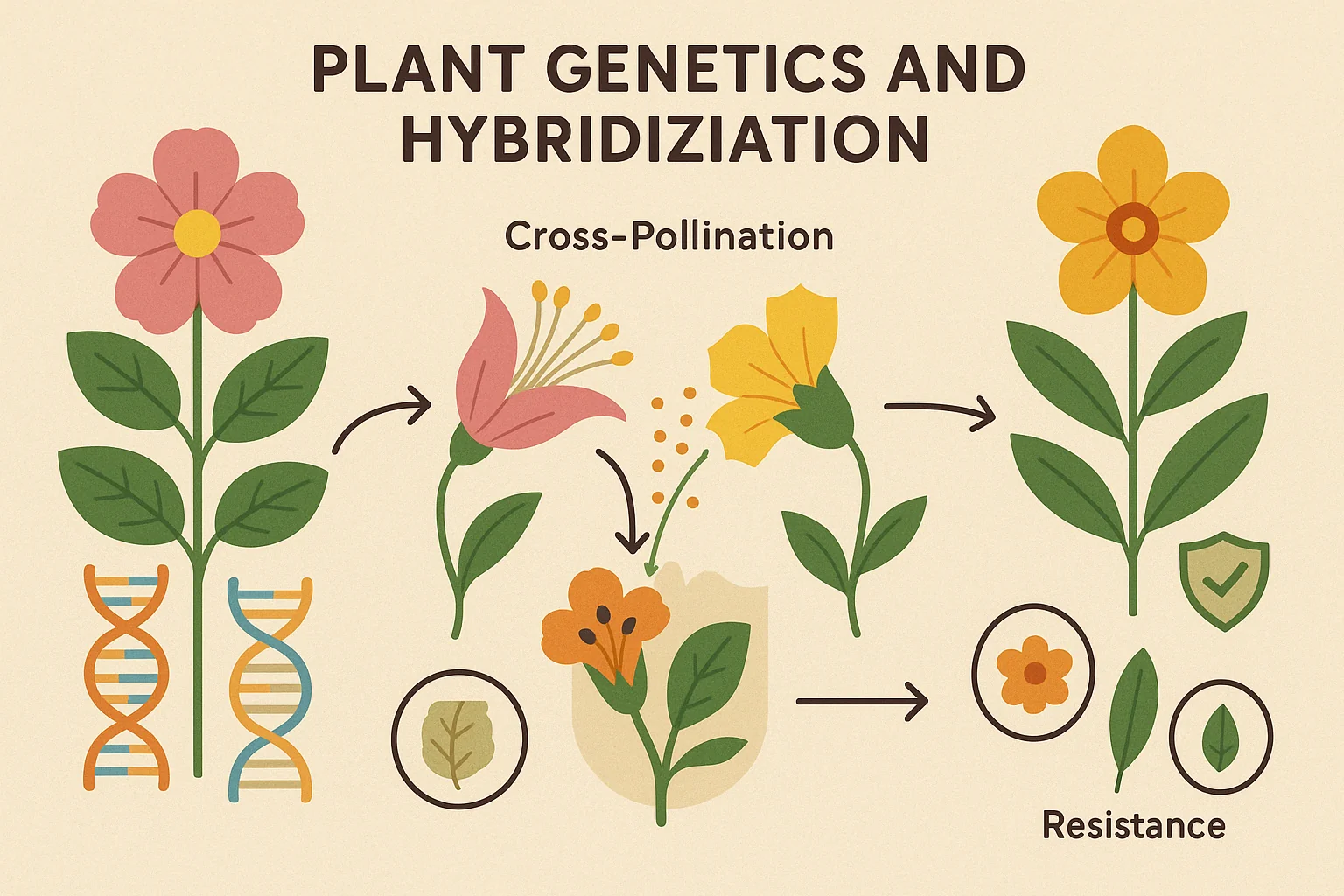
🧬 What is Plant Genetics? 🧬
Plant genetics is the study of genes, which are the units of heredity. These genes determine traits like flower color, leaf shape, and disease resistance. Every plant has two sets of genes: one from each parent plant. 🌿
🌻 What is Hybridization? 🌻
Hybridization is the process of cross-breeding two different plant varieties to create a new one. It combines the best traits of both parents, like improved size, color, or resistance to pests. 🌼
When you cross-pollinate plants, you mix their genetic material, which results in offspring with a unique blend of characteristics from both parents. This process can be done intentionally to create a plant that is more beautiful, more robust, or more productive. 🌺
🔬 How Does Hybridization Work? 🔬
Hybridization works by combining the pollen from one plant (the male parent) with the flower of another plant (the female parent). This creates seeds that grow into plants with traits from both parents. These traits might include better flowers, faster growth, or stronger disease resistance. 🌻
Understanding genetics and hybridization is the key to creating plant cultivars that thrive and stand out in your garden! ✨
🌸🌿 The Science Behind Cross-Pollination 🌸🌿
Cross-pollination is the heart of creating new plant cultivars. Let’s explore how it works and why it’s essential for hybridization.
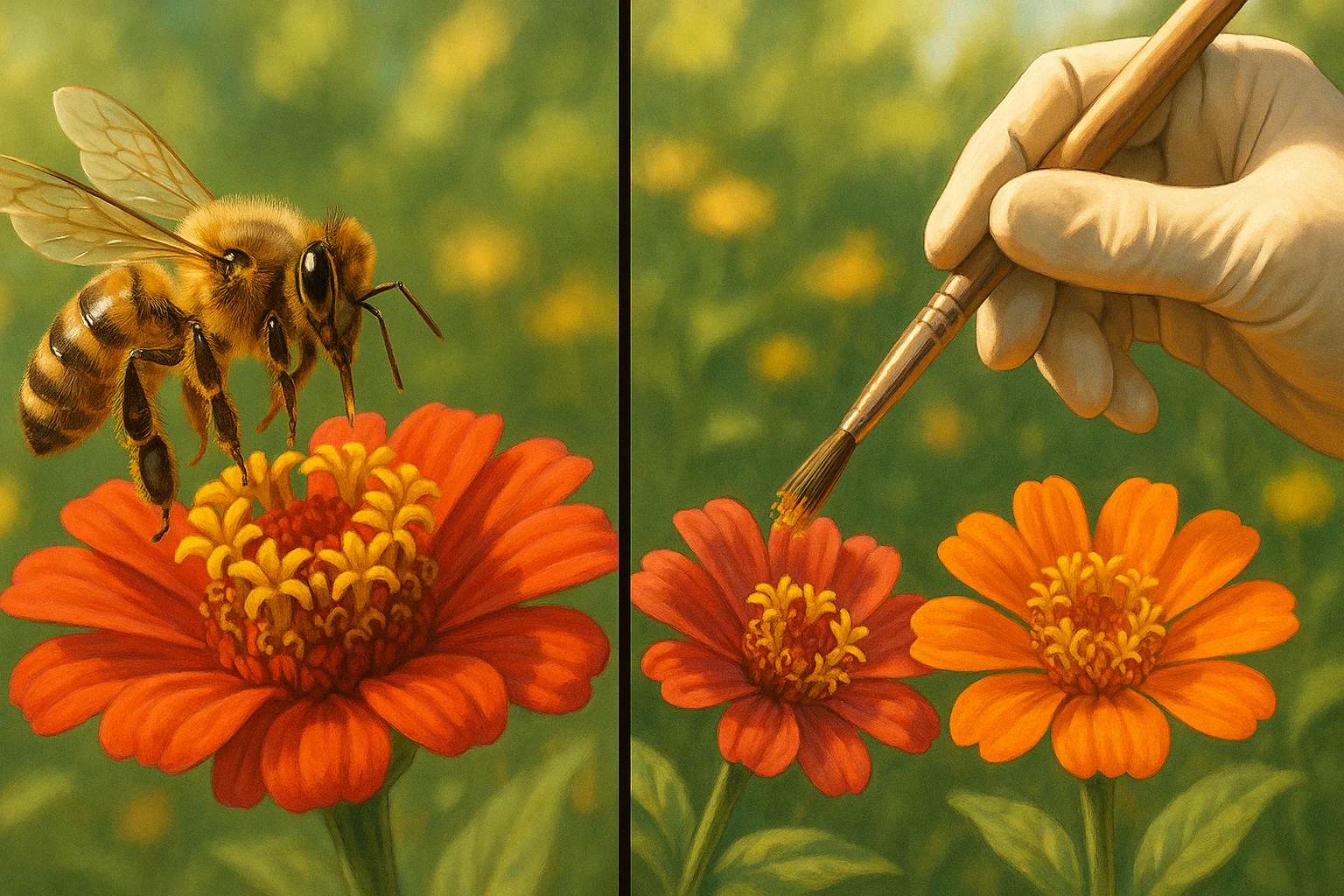
🌼 Pollination Methods 🌼
There are two main types of pollination:
- Self-Pollination 🌱: The plant’s own pollen fertilizes its own flowers.
- Cross-Pollination 🌺: Pollen from one plant is transferred to the flower of a different plant, often of the same species.

Cross-pollination is key to creating genetic diversity, which is what leads to new and improved plant cultivars. 🌳
🐝 The Cross-Pollination Process 🐝
- Pollen Transfer: In nature, insects (like bees 🐝) or the wind carry pollen from one plant to another. For human-guided cross-pollination, you’ll manually transfer the pollen using a brush or tweezers. 🖌️
- Fertilization: Once the pollen reaches the female flower (the pistil), fertilization occurs, and seeds are formed. These seeds will grow into plants with a mix of genetic traits from both parents. 🌾

🌻 Types of Cross-Pollination 🌻
- Open-Pollination 🌬️: Pollen is freely exchanged between plants without human intervention. This method is natural and can lead to unexpected hybrids.
- Controlled Pollination 🧑🔬: This is where you control which plants pollinate each other, ensuring specific traits are passed down.
⚠️ Challenges and Considerations ⚠️
- Genetic Compatibility: Not all plants are genetically compatible, and cross-pollination may not always succeed.
- Timing: Plants need to be in bloom at the same time for successful cross-pollination. ⏰
- Environmental Factors: Weather and insects play a big role in pollination, so it’s important to create a favorable environment.
Cross-pollination is an exciting process that introduces diversity into your plants. Understanding how it works is the first step toward successfully creating your own hybrid plants! 🌱
🌿🌸 Choosing Parent Plants for Cross-Pollination 🌿🌸
Selecting the right parent plants is crucial for successful cross-pollination. Here’s how you can choose the best plants to create the new cultivar you’re dreaming of! 🌱✨
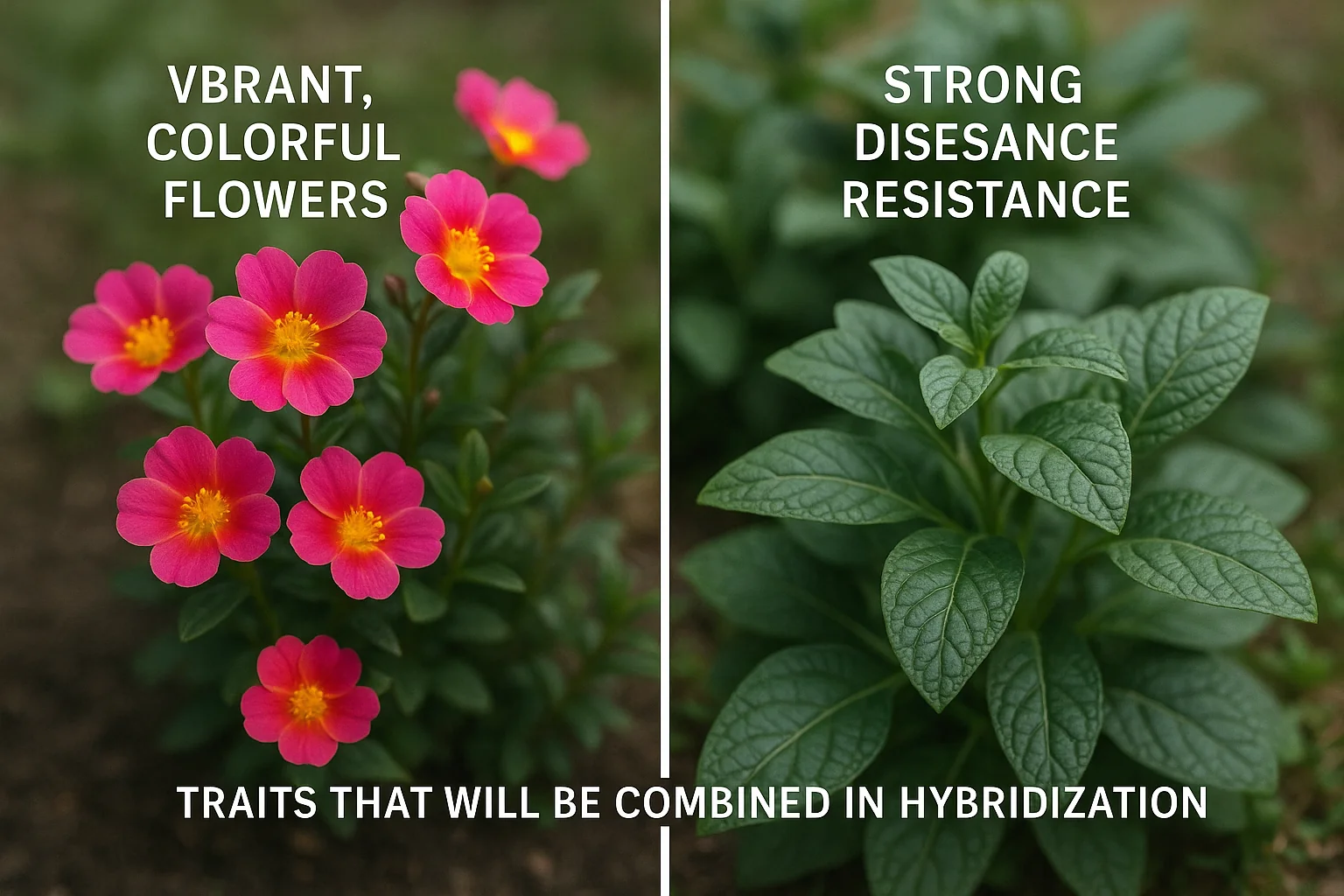
1. 🌺 Select Plants with Complementary Traits 🌺
Look for plants with desirable traits that you want to combine. For example, if you want a flower with vibrant colors and a plant with strong disease resistance, choose a parent plant with one trait and the other with the complementary one. 🌻
2. 🌳 Ensure Genetic Compatibility 🌳
For cross-pollination to work, the parent plants must belong to the same species or closely related species. This increases the chance that the plants will produce viable seeds with the traits you’re hoping for. 🌿
3. ⏳ Check Blooming Times ⏳
Timing is everything! Choose plants that bloom around the same time. If one blooms early and the other late, cross-pollination won’t happen. Make sure their flowering periods overlap so they can “meet” at the right time. 🌷
4. 🌱 Health and Vigor of the Parents 🌱
Only use healthy, strong plants for cross-pollination. Weak or sick plants may not produce high-quality seeds, and the hybrid might inherit unwanted characteristics. Healthy plants increase the chances of a successful hybrid! 🌿
5. 🌸 Consider Flower Size and Structure 🌸
The structure of the flower impacts how easily pollen can be transferred. Choose plants with flowers that allow easy access to the pistil and anthers. Some flowers may need special tools for pollination (like small brushes or tweezers). 🌼
By carefully selecting parent plants based on these factors, you’ll have a much higher chance of success when creating your own plant cultivars! 🌻
🌸🔬 Step-by-Step Guide to Cross-Pollination 🌸🔬
Ready to create your own plant hybrids? Here’s a simple, step-by-step guide to help you successfully cross-pollinate plants and create new cultivars! 🌱
1. 🌿 Prepare the Parent Plants 🌿
- Choose healthy plants that are in their flowering stage.
- Ensure blooming overlap (flowers should be open at the same time).
- Make sure plants are well-watered and healthy, as stress can affect pollination success. 🌺
2. 🖌️ Gather Your Tools 🖌️
- Small paintbrush or cotton swab to collect pollen.
- Tweezers or fine scissors for handling delicate flowers.
- Paper bag or a small container to cover flowers and prevent unwanted pollen from mixing in. 🛍️
3. 🌼 Collect Pollen from the Male Parent Plant 🌼
- Gently use your brush or cotton swab to collect pollen from the anthers (male part of the flower).
- Be careful not to damage the flower. Ensure the pollen is fresh and ready to be transferred. 🌻

4. 🌷 Transfer Pollen to the Female Parent Plant 🌷
- Carefully transfer the collected pollen to the pistil (female part) of the flower on the second plant.
- Gently brush the pollen onto the stigma (the sticky part of the pistil). Try to cover the stigma evenly for the best chance of fertilization. 🌸
5. 🌼 Secure the Pollinated Flower 🌼
- After pollination, cover the flower with a paper bag or mesh cover to prevent cross-pollination from other plants.
- This ensures only the pollen you’ve applied will fertilize the flower. 🛡️
6. ⏳ Wait for Fertilization ⏳
- Keep an eye on the pollinated flower. In a few weeks, you’ll start to see the development of seeds. 🌾
- If the fertilization is successful, the flower will start to form a seed pod or fruit. 🌿
7. 🌱 Harvest the Seeds 🌱
- Once the seed pod or fruit matures, carefully harvest the seeds.
- Be patient — this process can take some time, depending on the plant species. 🌸
8. 🌱 Germinate and Grow the Hybrid Seeds 🌱
- Plant your seeds in nutrient-rich soil, and care for them just like any other seeds.
- Watch as your hybrid plants grow with a mix of characteristics from both parent plants! 🌿
By following these simple steps, you’ll be on your way to creating unique, healthy plant cultivars that reflect the best traits from your parent plants! 🌺
🌱🌼 Growing the New Hybrid Plant 🌱🌼
Congratulations on successfully cross-pollinating! Now it’s time to grow your new hybrid plant and nurture it into a thriving beauty. Here’s how to care for it during its early stages. 🌿✨
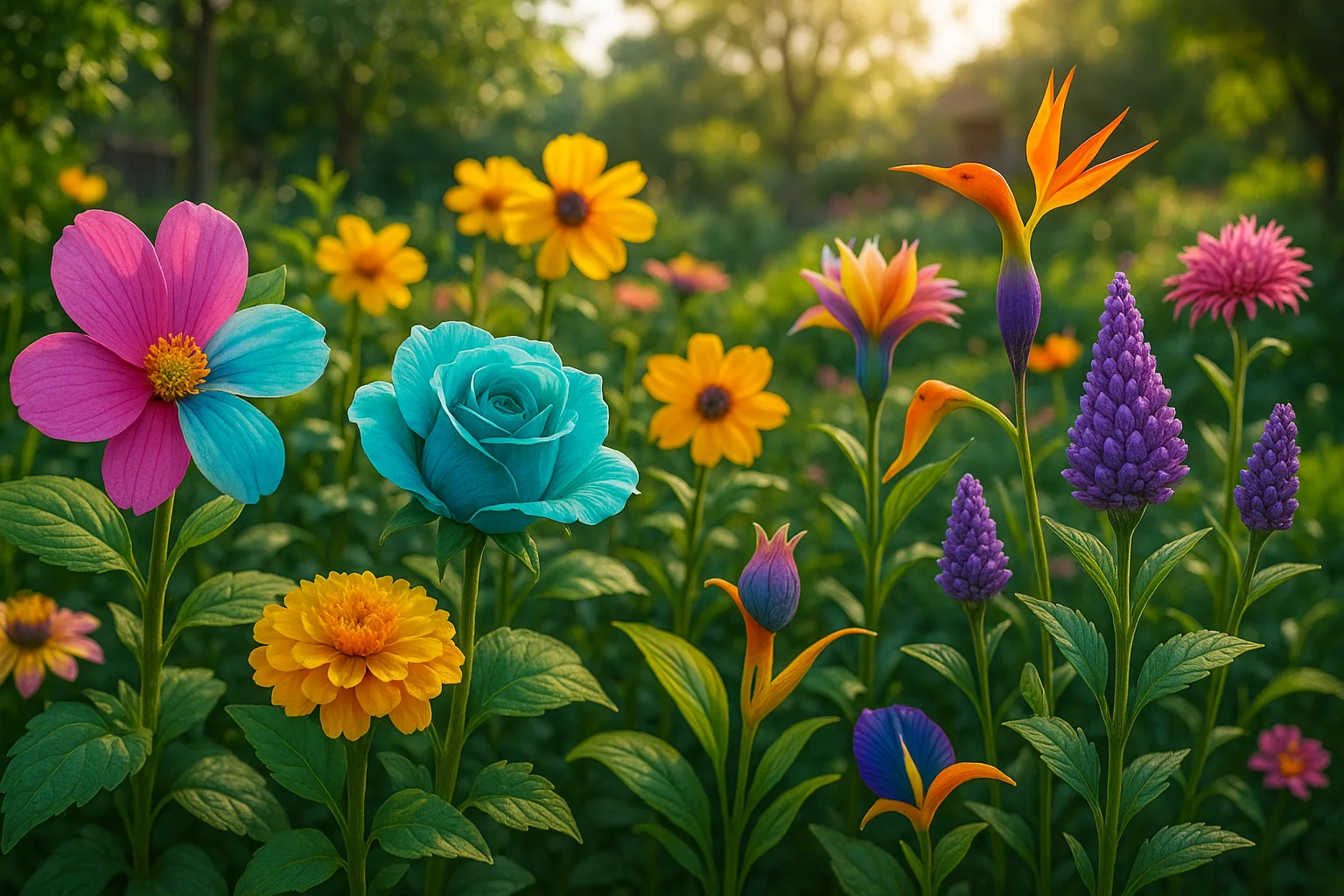
1. 🌾 Seed Development and Harvesting 🌾
- After pollination, give the plant plenty of time to develop seeds. This can take a few weeks or months, depending on the plant species.
- Once the seeds are mature, you’ll notice the seed pod or fruit beginning to dry out and crack open. Carefully collect the seeds when they’re fully ready. 🧑🌾
2. 🌱 Germinating the Seeds 🌱
- Plant your hybrid seeds in well-draining soil. Ensure the soil is nutrient-rich and light enough for young roots to grow.
- Keep the soil lightly moist, but avoid overwatering. Most hybrid seeds need warmth to germinate, so place them in a sunny spot or under a grow light. 🌞
- Be patient, as germination can take anywhere from a few days to several weeks, depending on the plant type. 🌿
3. 🌱 Early Growth and Care 🌱
- Once the seeds sprout, give them plenty of light to encourage strong, healthy growth. If growing indoors, place them near a window or under a grow light.
- Water regularly, but don’t let the soil stay soggy. Make sure the seedlings have good airflow to prevent mold or mildew. 🌬️
- Once the plants grow a bit taller, you can start to thin them out by removing weaker seedlings to allow the stronger ones to flourish. 🌸
4. 🏡 Transplanting the Seedlings 🏡
- When the seedlings have grown large enough to handle, it’s time to transplant them into larger pots or your garden.
- Choose a spot with plenty of sunlight, and make sure the soil is well-draining to avoid root rot. 🌞
- If transplanting outdoors, ensure the weather is warm enough for the hybrid plants to thrive and won’t risk frost damage. ❄️
5. 🌿 Ongoing Care and Maintenance 🌿
- Continue caring for your hybrid plant by providing regular water, nutrients, and sunlight.
- Watch for signs of pests or diseases and take action early to protect your plant. 🌸
- As the plant matures, observe its traits—color, shape, growth habit—and enjoy the unique qualities it inherited from both parent plants! 🌻
Growing a hybrid plant is a rewarding experience, and with the right care, your new creation will thrive and add beauty to your garden or home. 🌺
🌱🌸 Evaluating the Success of the Hybrid 🌱🌸
After nurturing your hybrid plant, it’s time to assess how well your cross-pollination experiment has turned out. Here’s how to evaluate if your hybrid plant is a success! 🌿
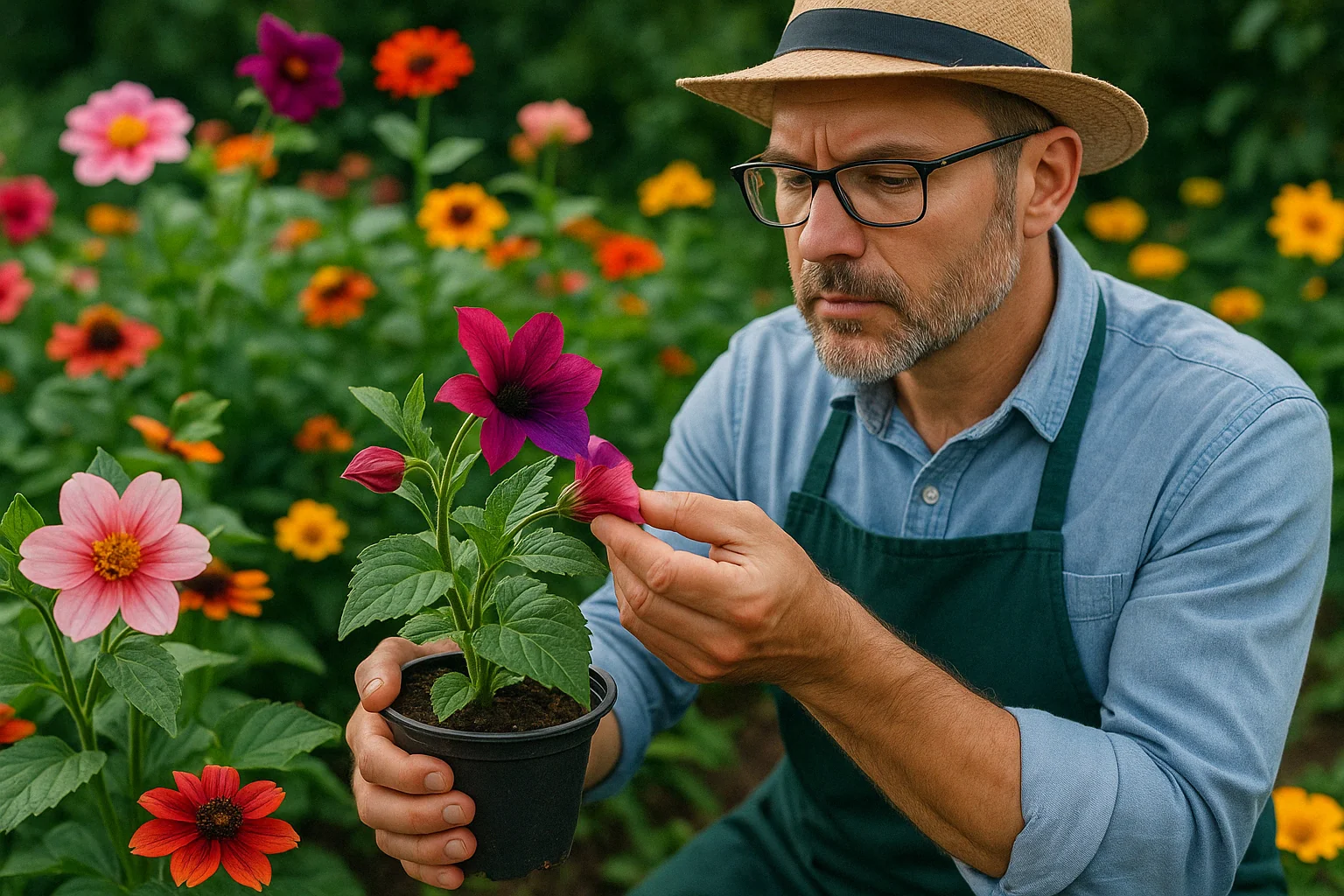
1. 🌻 Check for Desired Traits 🌻
The most important aspect of evaluating a hybrid is seeing if it has inherited the traits you were hoping for. Look for:
- Color and Size: Does the hybrid have the vibrant color or larger size you aimed for? 🌺
- Growth Habit: Is it growing in the way you envisioned? Is it more compact, taller, or bushier? 🌳
- Flower or Fruit Quality: Has the hybrid improved in terms of blooming frequency, size, or fragrance? 🍓
2. 🌿 Test for Health and Hardiness 🌿
A successful hybrid should be resilient and healthy. Evaluate how well your hybrid:
- Resists Pests and Diseases: Is it more pest-resistant than its parent plants? 🐛
- Thrives in Your Environment: Does it adapt well to the growing conditions, whether indoors or in the garden? 🌞
- Performs in Different Conditions: Test if it’s adaptable to different watering, light, and temperature conditions. 🌡️
3. 🌾 Measure Growth and Yield 🌾
For food or ornamental hybrids, check if the plant’s growth and yield are improved:
- Faster Growth: Has the hybrid plant shown quicker growth than the parents? 🌱
- Increased Yield: If it’s a fruit or vegetable, evaluate the quantity and quality of the produce. 🍅
4. 🌿 Genetic Stability 🌿
The true success of a hybrid is determined by its ability to pass on the traits consistently in future generations. If you’re planning to keep creating hybrids, check if the plant’s characteristics are stable and if they can be reproduced by saving and planting seeds. 🌾
5. 🌻 Overall Aesthetics 🌻
Sometimes the beauty of a plant is just as important as its practicality. Is your hybrid visually appealing? Does it add unique beauty to your garden or home décor? 🌷
6. 👩🌾 Gather Feedback (If Sharing) 👩🌾
If you share your hybrid plant with others, take note of their feedback. Do they find it easy to grow? Are they impressed with the plant’s qualities? Their insights can help you refine your future cross-pollination projects. 🌿
By evaluating these factors, you’ll be able to determine whether your hybrid was a successful cross-pollination experiment or if there’s room for improvement in future attempts. 🌱
🚫🌸 Common Mistakes to Avoid in Cross-Pollination 🚫🌸
Cross-pollination can be a rewarding process, but it’s important to avoid some common mistakes that could affect the success of your hybrid plant creation. Here are the most common pitfalls and how to steer clear of them! 🌿
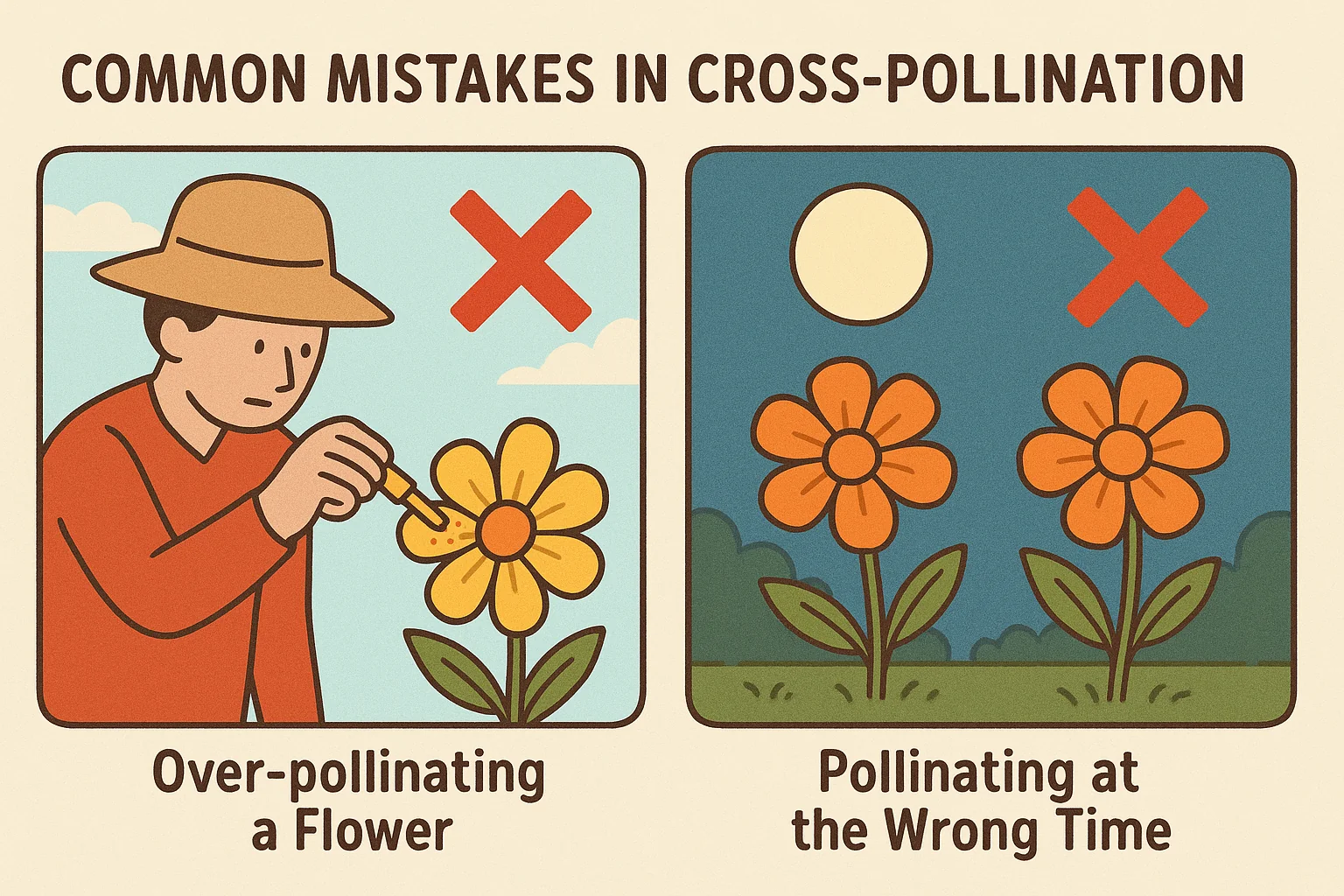
1. 🌱 Ignoring Plant Compatibility 🌱
Not all plants are genetically compatible for cross-pollination, and attempting to cross incompatible species can result in poor or non-viable seeds. Always make sure the parent plants are from the same species or closely related species. 🌻
2. 🕰️ Pollinating at the Wrong Time 🕰️
Timing is crucial! Pollinating too early or too late in the blooming cycle can prevent successful fertilization. Make sure the flowers are fully open and ready to receive pollen. 🌸
3. 🌿 Not Using Fresh Pollen 🌿
Pollen loses its viability over time. Using old or dried-out pollen can result in poor fertilization. Always collect fresh pollen just before transferring it to the female plant. 🌼
4. 🌺 Over-pollination 🌺
Applying too much pollen or pollinating too many flowers can result in weak hybrid plants. Less is more when it comes to pollen transfer—apply a light dusting to the stigma for best results. 🖌️
5. 🛑 Not Isolating Pollinated Flowers 🛑
Once pollinated, it’s important to protect the flower from unwanted pollen. Use a paper bag or mesh cover to prevent other pollen from contaminating your hybrid experiment. 🌱
6. 🧬 Failing to Check for Genetic Stability 🧬
It’s easy to get excited about your new hybrid, but always test its genetic stability before saving seeds for future generations. Without stable genetics, your hybrid may not maintain the desired traits when grown from seed. 🌾
7. 🌿 Poor Care of Seedlings 🌿
Once your seeds have germinated, neglecting their care can stunt their growth. Ensure they get adequate water, light, and nutrients, and provide proper space for healthy development. 🌞
8. 🐛 Not Monitoring for Pests and Diseases 🐛
Pests and diseases can quickly damage hybrid plants, especially during the early stages. Keep a close eye on your plants and treat them promptly if any issues arise. 🌸
By avoiding these common mistakes, you’ll increase your chances of successfully creating strong, healthy hybrid plants that bring out the best traits from your parent plants! 🌱
⚖️🌿 Ethical Considerations and Legal Aspects ⚖️🌿
When creating new plant cultivars through cross-pollination, there are ethical and legal factors you should be aware of. Here’s what to keep in mind as you embark on your hybridization journey! 🌱
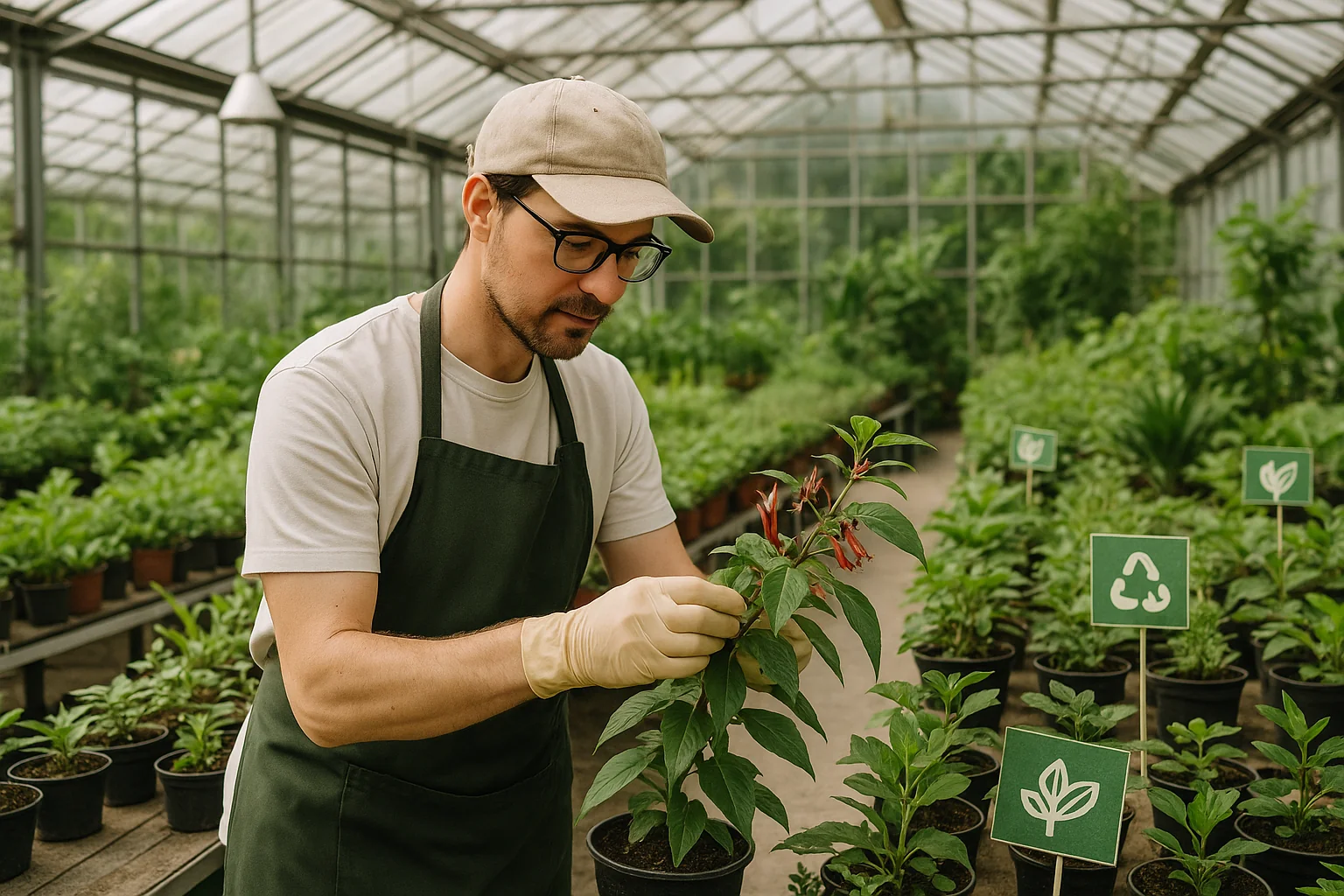
1. 🌍 Respect for Nature and Biodiversity 🌍
Creating new plant cultivars can be exciting, but it’s important to consider the impact on the environment. Hybridizing plants should be done responsibly to avoid harming local ecosystems. Be mindful of:
- Invasive Species: Some hybrid plants may become invasive if they are released into non-native environments. Always check if the plant could potentially disrupt local flora. 🌾
- Biodiversity: Avoid creating hybrids that might harm the natural genetic diversity of local plant populations. Ensure your hybrid is beneficial, not harmful. 🌻
2. 🧑⚖️ Protecting Intellectual Property 🧑⚖️
If you’ve created a unique hybrid, it’s essential to understand your rights and options for protecting it:
- Patent Protection: You can patent your new cultivar if it is unique, stable, and distinct from other plants. This gives you exclusive rights to sell or propagate the plant. 🌸
- Plant Breeder’s Rights: Many countries offer legal protection for new plant varieties through plant breeder’s rights (PBR), which grants you control over its commercial use. 📜
3. 🤝 Consent and Respect for Other Breeders 🤝
If you’re using plant varieties from other breeders or institutions, make sure you have permission or licenses to use those plants in your hybridization work. Respect intellectual property laws and avoid copying or infringing on another’s creation. 🛑
4. 🧬 Ethical Use of Genetically Modified Organisms (GMOs) 🧬
While cross-pollination is a natural method of hybridization, be cautious if you’re working with genetically modified plants. GMOs have stricter regulations and ethical concerns surrounding their impact on the environment and human health. 🌱
5. 💼 Commercialization and Sustainability 💼
If you plan to sell your hybrid plants, consider the sustainability of your cultivation methods. Avoid using harmful pesticides or unsustainable practices, and focus on eco-friendly growing methods. 🌍
6. 🧠 Respecting Local and Indigenous Knowledge 🧠
If you’re working with plant species that have traditional or cultural significance, it’s essential to acknowledge and respect the knowledge of local communities or indigenous groups who have been cultivating these plants for generations. Ensure you’re not exploiting their practices or resources without proper recognition. 🌿
By considering these ethical and legal factors, you can responsibly create new plant cultivars while protecting your work and the environment. Stay informed, and always proceed with respect for nature and the law! Creating New Plant Cultivars by Cross-Pollination is an exciting journey that blends innovation with responsibility.🌻
🌱🌸Final Thoughts 🌱🌸
Creating new plant cultivars by cross-pollination is a fascinating and rewarding journey that allows you to combine the best traits of different plants to form something entirely new. Whether you’re aiming for stronger growth, unique colors, or improved resistance to pests and diseases, the process can lead to exciting results for both gardeners and plant enthusiasts. 🌿

By understanding plant genetics, choosing the right parent plants, and following the step-by-step process of cross-pollination, you can successfully create hybrids that will thrive in your garden or home. Remember, patience and care are key at every stage, from pollination to growing and evaluating your new hybrid plant. 🌷
As you explore the world of plant hybridization, keep ethical considerations in mind, respect intellectual property rights, and always ensure that your creations contribute positively to biodiversity and the environment. 🌍
With the knowledge gained from this guide, you’re now ready to start your own cross-pollination experiments, unlocking a world of possibilities for new plant cultivars. Happy gardening and happy hybridizing! 🌱✨
Frequently Asked Questions (FAQ)
What is cross-pollination and how does it work?
Cross-pollination is the process of transferring pollen from the male part of one flower to the female part of another flower, typically from a different plant, to create a hybrid offspring. It involves pollinators, such as insects, or can be done manually by gardeners.
How do I choose the right plants for cross-pollination?
Selecting the right parent plants involves choosing species or varieties that are compatible. Look for plants within the same species or closely related species to ensure genetic compatibility for successful hybridization.
Can I cross-pollinate any type of plant?
Not all plants can be cross-pollinated successfully. The plants must be genetically compatible, and it is often more successful when both plants are within the same species or genus. For example, you can cross-pollinate different varieties of tomatoes, but not a tomato with a potato.
Do I need special tools for cross-pollination?
You’ll need a small brush, cotton swab, or fine-tipped tool to collect and transfer pollen from one flower to another. You’ll also want something to cover the pollinated flower, like a paper bag or mesh, to prevent contamination.
How do I know if my cross-pollination was successful?
A successful cross-pollination will result in the formation of seeds or fruits after a few weeks. The flowers should also look healthy and viable. Be patient and watch for the seeds to mature so you can harvest them.
What should I do with the seeds from my hybrid plants?
Once your hybrid plant produces seeds, you can harvest them and plant them like any other seeds. However, it’s important to remember that hybrid seeds may not always produce plants with the exact same characteristics as the parent plants.
Are there any legal restrictions when creating hybrids?
Yes, if you’re creating and selling hybrids, it’s important to be aware of patent laws and plant breeder’s rights. Some hybrids can be patented, and unauthorized use of patented plants could lead to legal issues. Always check for intellectual property rights before propagating and selling your hybrid plants.
How long does it take for a hybrid plant to grow?
The growth time of a hybrid plant depends on the species involved, but it typically takes a few weeks to a few months for seeds to germinate, and it could take several months to years before the hybrid reaches maturity, depending on the plant’s growth rate.
